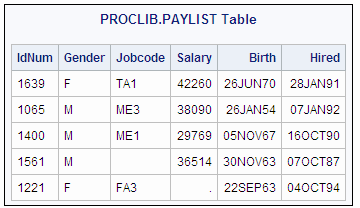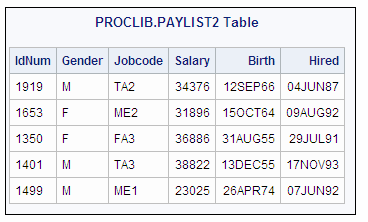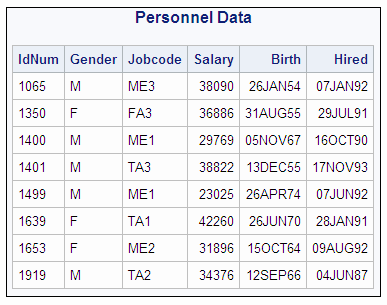SQL Procedure
- Syntax
 Procedure SyntaxPROC SQL StatementALTER TABLE StatementCONNECT StatementCREATE INDEX StatementCREATE TABLE StatementCREATE VIEW StatementDELETE StatementDESCRIBE StatementDISCONNECT StatementDROP StatementEXECUTE StatementINSERT StatementRESET StatementSELECT StatementUPDATE StatementVALIDATE Statement
Procedure SyntaxPROC SQL StatementALTER TABLE StatementCONNECT StatementCREATE INDEX StatementCREATE TABLE StatementCREATE VIEW StatementDELETE StatementDESCRIBE StatementDISCONNECT StatementDROP StatementEXECUTE StatementINSERT StatementRESET StatementSELECT StatementUPDATE StatementVALIDATE Statement - Overview
- Examples
 Creating a Table and Inserting Data into ItCreating a Table from a Query's ResultUpdating Data in a PROC SQL TableJoining Two TablesCombining Two TablesReporting from DICTIONARY TablesPerforming an Outer JoinCreating a View from a Query's Result Joining Three TablesQuerying an In-Line View Retrieving Values with the SOUNDS-LIKE Operator Joining Two Tables and Calculating a New ValueProducing All the Possible Combinations of the Values in a ColumnMatching Case Rows and Control RowsCounting Missing Values with a SAS Macro
Creating a Table and Inserting Data into ItCreating a Table from a Query's ResultUpdating Data in a PROC SQL TableJoining Two TablesCombining Two TablesReporting from DICTIONARY TablesPerforming an Outer JoinCreating a View from a Query's Result Joining Three TablesQuerying an In-Line View Retrieving Values with the SOUNDS-LIKE Operator Joining Two Tables and Calculating a New ValueProducing All the Possible Combinations of the Values in a ColumnMatching Case Rows and Control RowsCounting Missing Values with a SAS Macro
Example 5: Combining Two Tables
| Features: |
DELETE statement IS condition RESET statement option : DOUBLE UNION set operator |
| Table names: | PROCLIB.NEWPAY |
Input Tables
Program
libname proclib 'SAS-library';
proc sql;
create table proclib.newpay as
select * from proclib.paylist
union
select * from proclib.paylist2;
delete
from proclib.newpay
where jobcode is missing or salary is missing;
reset double;
title 'Personnel Data';
select *
from proclib.newpay;Program Description
Create the PROCLIB.NEWPAY table.The SELECT clauses select all the columns from the
tables that are listed in the FROM clauses. The UNION set operator
concatenates the query results that are produced by the two SELECT
clauses.
proc sql;
create table proclib.newpay as
select * from proclib.paylist
union
select * from proclib.paylist2;Delete rows with missing Jobcode or Salary values.The DELETE statement deletes rows from PROCLIB.NEWPAY
that satisfy the WHERE expression. The IS condition specifies rows
that contain missing values in the Jobcode or Salary column.
Reset the PROC SQL environment and double-space the output.RESET changes the procedure environment without stopping
and restarting PROC SQL. The DOUBLE option double-spaces the output.
(The DOUBLE option has no effect on ODS output.)
Copyright © SAS Institute Inc. All rights reserved.


